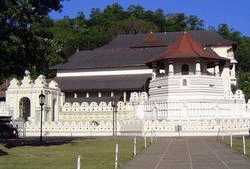In Buddhism, the cult of sacred relics is widespread and connected with temple worship. According to the tradition, Emperor Ashoka in India, who reigned in the 3rd century BC, was responsible to distribute some 84,000 relics left over after the cremation of the Buddha some 2,500 years ago. Today, these relics are contained in various temples scattered across Asia.
 One of the most sacred temples is certainly the “Temple of the Sacred Tooth” in Kandy, Sri Lanka, where one of the four canine teeth of the Buddha is housed and worshiped. As the Buddhist look upon it as a living being, food and drinks are offered to it every morning, noon, and evening.
One of the most sacred temples is certainly the “Temple of the Sacred Tooth” in Kandy, Sri Lanka, where one of the four canine teeth of the Buddha is housed and worshiped. As the Buddhist look upon it as a living being, food and drinks are offered to it every morning, noon, and evening.
Kandy was the last royal capital of the Sri Lanka island kingdom, which ended in 1815, when the last king of Kandy, Sri Vikrama Rajasingha, was dethroned by the British. Only then, Colombo became the new capital until today. But Kandy is still known for a cultural festival that is held in the Sinhala month of Esala (July-August), which marks the end of the dry season and the beginning of the wet season. During this festival called “Esala Perahera,” the Buddha’s sacred tooth is paraded in a golden casket on the back of a tasked elephant through the streets of Kandy that Buddhists believe has the magical power to make it rain.
Interesting to note is how the sacred tooth came from India to Sri Lanka. According to historical records, the Kalinga princess Hemamala of Danta Pura, in today’s Orissa, took the sacred tooth to Sri Lanka by sea and handed it over to the king of this land, Kit Siri Mevan, who reigned in his capital Anuradhapura during 303-331 AD. From that time on, the sacred tooth relic wandered from capital to capital. King Vimaladharmasurya I (1591-1604) brought the sacred tooth to his new capital of Kandy, when the Portuguese, who resided in Goa, India, threatened to destroy the relic. Actually, they did it, but it was not the real tooth.
The annual Esala Perahera is nowadays held on ten successive nights and ends in the morning of the full moon day of Esala. The elephants play an important role in the Festival of the Sacred Tooth Relic because they symbolize the rain clouds that gather just before a downpour of rain. Special rain-gods such as Natha, Vishnu, Kataragama, and Pattini take part in the festival, too. Also, the “perahera” features several troupes of musicians with drums, wind instruments, and cymbals, as well as colorful folk dances. There are whip-crackers symbolizing the sound of thunder and some torchbearers symbolizing lightening.
The highlight of the Esala Perahera is certainly the so-called “water-cutting” ceremony, when the lay-priests of the rain-gods go in procession to the Mahaveli Ganga and row a boat hidden with a white cloth to the middle of the river with golden swords and caskets. There, the refilling of the caskets is done in a magical way. With the rains that come after the water-cutting ceremony, the rain-retreat of the Buddhist monks begins and will last for three months to come.
By Reinhard Hohler
Source: www.eturbonews.com




